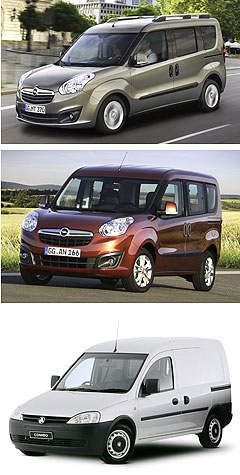Holden ponders new Combo
BY DAVID HASSALL | 20th Oct 2011

Vauxhall in the UK this week revealed the latest generation of the van – the first all-new Combo in a decade – that will be built in Turkey alongside the Fiat Doblo on which it is based, ahead of UK sales commencing in February.
Although production of the outgoing Barina-based model has already concluded, Holden ordered sufficient quantities to ensure the XC Combo – which is priced from $21,280 plus on-roads and has been sold here since 2002 – will remain available in Australia well into next year.
While giving the Combo an Opel badge would potentially enable GM to sell the van at a higher price and with a greater profit margin, that would prevent the new model coming here for almost a year as the Opel brand is being launched at the Australian International Motor Show in October 2012.
Combo sales have declined steadily since 2004 as more modern rivals have arrived on the scene and are now barely a trickle, averaging just 33 units a month this year compared with 100 a month seven years ago.
Sales are down one-third this year alone, leaving the Combo well behind the small van segment-leading VW Caddy and not far ahead of the Renault Kangoo, which was launched in Australia only 10 months ago, and even the ageing Suzuki APV.
“A decision is still pending on the new model,” Holden senior manager product communications Kate Lonsdale told GoAuto.

“We are looking at pricing and the market and all those things, so it’s all to be confirmed.”Ms Lonsdale said there was plenty of XC run-out stock, so it was not urgent, and confirmed that the decision involved whether the Combo would wear Opel or Holden badges if it comes here.
“That is to be considered as part of the review process,” she said.
Vauxhall will launch the Combo van in two wheelbases offering lengths of 4390mm and 4740mm, two heights (1850mm and 2100mm), two gross vehicle weights (2000kg and 2300kg) and two payloads (750kg and 1000kg with driver).
The company claims that Combo will have the highest payload, largest load volume (up to 4.2 cubic metres), highest rear axle capacity (1450kg) and longest wheelbase in the small van sector.
The short-wheelbase model provides 3400 litres of load volume and a load length of 1820mm, while the long-wheelbase model has a volume of 4200 litres and a length of 2170mm. Cargo width in both is 1710mm.
Vauxhall claims a low loading height (545mm) combined with wide-opening sliding side doors enable easier loading and convenient access to cargo.
An optional upward opening flap built into the rear of the roof of some models enable the secure transport of longer loads such as ladders and pipes.
For the UK market, only a four-engine range of four-cylinder diesels will be available – a 1.3-litre and 1.6-litre each developing 66kW of power, a 1.6-litre with 77kW and a 2.0-litre unit producing 99kW.
They are combined with a variety of five-speed and six-speed manual and automatic transmissions, and most powertrains are available with idle-stop functionality to reduce fuel consumption and emissions.
Other Combo engines – as revealed when the glass-sided passenger version was unveiled in July – will include a 1.4-litre petrol four producing 70kW (4kW more than the current engine fitted to Australian Combos) and one powered by compressed natural gas (CNG) that produces 88kW.
GM claims outstanding all-round vision from inside the Combo, thanks to a steeply raked and deep windscreen, low bonnet line and ‘panoramic’ side mirrors.
Fiat’s designers mounted the tail-light clusters up high to avoid incidental damage while recessing the optional front fog lights to protect them.
Inside, the steering wheel is adjustable for both rake and reach, and there are numerous storage compartments, including an overhead storage shelf, dashboard storage and a lockable glove box that can hold a laptop.
Standard equipment in the UK will include remote central-locking with deadlocks, trip computer, electric power steering, driver’s airbag, ABS with EBD and a 12 volt power outlet in the dashboard.
More upmarket ‘Sportive’ models will come with air-conditioning, metallic paint, body-colour bumpers and door mirrors, a second sliding door, an armrest, and height adjustment and lumbar support on the driver’s seat.
Options will include cruise control, rear parking sensors, automatic climate control, electronic stability control, hill-hold function front passenger’s airbag, side airbags, glazed rear doors or tailgate, longitudinal roof bars and winter tyres.